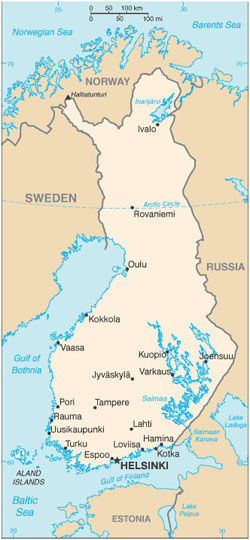Welcome to the Virtual Education Wiki ~ Open Education Wiki
Finland
Finland for VISCED by Merja Sjöblom, Finnish Information Society Development Centre
Partners situated in Finland
Finnish Information Society Development Centre
Finland in a nutshell
(mainly sourced from: Wikipedia)
Source: https://www.cia.gov/library/publications/the-world-factbook/geos/fi.html
Finland, officially the Republic of Finland, is a Nordic country situated in the Fennoscandian region of Northern Europe. The capital city of Finland is Helsinki. The population of Finland is about 5.4 million people, the majority concentrated in the southern region. It is the eighth largest country in Europe in terms of area and the third most sparsely populated country in the Europe. Finland is a parliamentary republic with a central government based in Helsinki and local governments in 336 municipalities.
Finland has been a member of the European Union since 1995, independent since 1917 and autonomous since 1809. Finland has two official languages: Finnish and Swedish. Finnish is spoken by 92 % and Swedish by 6 % of the population. The Sami language is an official language in northern Lapland and it is the mother tongue of about 1,700 people.
Education in Finland
(mainly sourced from: Ministry of Education)
Finnish education and science policy stresses quality, efficiency, equity and internationalism. It is geared to promote the competitiveness of Finnish welfare society. Sustainable economic development will continue to provide the best basis for assuring the nation's cultural, social and economic welfare. The overall lines of Finnish education and science policy are in line with the EU Lisbon strategy.
In Finland, the basic right to education and culture is recorded in the Constitution. Public authorities must secure equal opportunities for every resident in Finland to get education also after compulsory schooling and to develop themselves, irrespective of their financial standing. Legislation provides for compulsory schooling and the right to free pre-primary and basic education. Most other qualifying education is also free for the students, including postgraduate education in universities.
Parliament passes legislation concerning education and research and determines the basic lines of education and science policy. The Government and the Ministry of Education and Culture, as part of it, are responsible for preparing and implementing education and science policy. The Ministry of Education and Culture is responsible for education financed from the state budget. The Government adopts a development plan for education and research every four years.
The Finnish education system is composed of nine-year basic education (comprehensive school), preceded by one year of voluntary pre-primary education; upper secondary education, comprising vocational and general education; and higher education, provided by universities and polytechnics. Adult education is available at all levels.
Schools in Finland
(mainly sourced from: Ministry of Education)
Children permanently living in Finland have a statutory right and obligation to complete the comprehensive school syllabus. Nearly all children (99.7%) do this. The principle underlying pre-primary, basic and upper secondary education is to guarantee basic educational security for all, irrespective of their place of residence, language and economic standing.
All children have the right to participate in voluntary pre-primary education during the year preceding compulsory schooling. Nearly all 6-year-olds do so. A Finnish child usually starts schooling at the age of seven. The nine-year basic schooling is free for all pupils. Local authorities arrange voluntary morning and afternoon activities for first- and second-year pupils and for special-needs pupils.
General upper secondary education commonly takes three years to complete and gives eligibility for polytechnic and university studies. At the end of the upper secondary school students usually take the national matriculation examination.
Pre-Primary education
Pre-primary education is available free of charge for children one year before they start actual compulsory schooling. Its aim is to develop children's learning skills as part of early childhood education and care. Local authorities have statutory duty to arrange pre-primary education, but for children participation is voluntary and decided by parents. About 96% of the six-year-olds go to pre-primary school.
The Ministry of Education recommends that a pre-primary teaching group only include 13 children, but if there is another trained adult in addition to the teacher it may have up to 20 children. Pre-primary instructors have either a kindergarten teacher qualification or a class teacher qualification.
Basic education
Basic education is free general education provided for the whole age group. After completing the basic education syllabus young people have finished their compulsory schooling. It does not lead to any qualification but gives eligibility for all upper secondary education and training.
Basic education in brief:
- Basic education is free nine-year education provided in comprehensive schools.
- The local/school curriculum is based on a national core curriculum.
- Education is provided in neighborhood schools or other suitable places which make school travel as short and safe as possible.
- Schools cooperate with pupils' homes.
- A pupil is entitled to special-needs education, if necessary.
- It is possible to continue basic education on a voluntary basis (for a tenth year).
- A school-leaving certificate is issued on the completion of the syllabus, but it does not give any actual qualification.
- The certificate gives access to all upper secondary education and training.
- Teachers are highly educated.
- Nearly all children complete their compulsory schooling.
Compulsory schooling starts in the year when children turn seven and ends after the basic education syllabus has been completed or after ten years.
